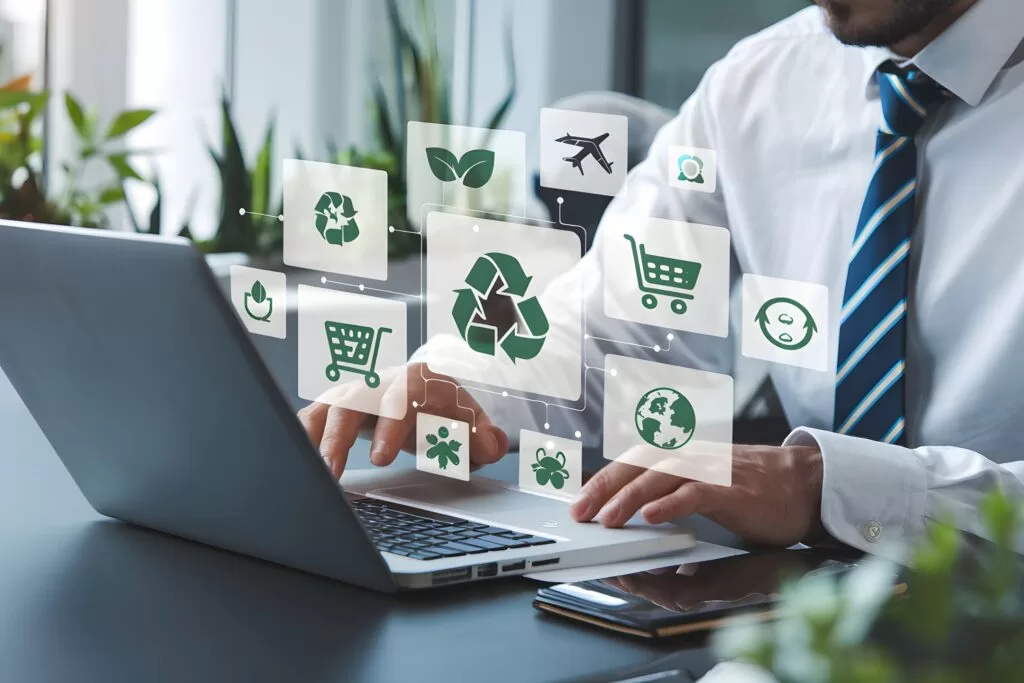Happy Eco News How To Build A More Resilient Business With Green Supply Chain Practices
Reading Time: 6 minutes
How To Build A More Resilient Business With Green Supply Chain Practices
In today’s competitive market, businesses must prioritize sustainability to remain resilient and adaptable. Adopting green supply chain practices can help reduce environmental impact, enhance operational efficiency, lower costs, and strengthen brand reputation. Companies that integrate eco-friendly strategies into their supply chains can position themselves for long-term success while meeting growing consumer demand for sustainable products.
Read on to learn how to build a more resilient business with green supply chain practices.
The Importance of Green Supply Chains
A green supply chain focuses on minimizing waste, reducing carbon emissions, and optimizing resource use at every stage, from sourcing raw materials to product delivery. Businesses that embrace these practices can benefit from improved regulatory compliance, reduced energy consumption, and stronger relationships with environmentally conscious partners. For example, switching to custom wood pallets can significantly decrease waste and improve logistics efficiency compared to traditional, non-recyclable alternatives.
Key Strategies for Building a Sustainable Supply Chain
A sustainable supply chain can minimize environmental impact while boosting efficiency and resilience. Below are some key strategies for building a sustainable supply chain:
Sustainable Sourcing and Procurement
Responsible sourcing is the foundation of a green supply chain, ensuring that materials are obtained ethically and environmentally conscious. Companies should prioritize suppliers that comply with fair labor practices, avoid deforestation, and minimize harmful emissions. Certifications can also help verify sustainability claims.
By choosing recycled metals, organic fabrics, or renewable resources, businesses can help reduce their ecological impact while supporting ethical industries. Transparent supplier audits and long-term partnerships can strengthen sustainability efforts, creating a resilient and responsible procurement process that aligns with global environmental goals.
Energy-Efficient Transportation and Logistics
Transportation is a major contributor to greenhouse gas emissions, making efficiency a key focus for sustainable supply chains. Switching to fuel-efficient or electric vehicles, optimizing delivery routes with AI-powered logistics software, and consolidating shipments to reduce empty loads can significantly lower carbon footprints. For long-haul freight, rail and maritime transport are far more sustainable than air or road alternatives due to their lower emissions per ton-mile.
Additionally, investing in alternative fuels, such as biodiesel or hydrogen, can further reduce environmental impact. These strategies can help cut operational costs and enhance compliance with tightening emissions regulations, positioning businesses as leaders in eco-friendly logistics.
Waste Reduction Through Circular Practices
The circular economy can transform waste into value by keeping materials in use longer through innovative reuse strategies. For instance, businesses can implement closed-loop systems where products are designed for disassembly and materials are continuously repurposed. Industrial byproducts can be upcycled into new materials, such as wood scraps becoming particleboard or fabric remnants transformed into insulation. Take-back programs can encourage customers to return used items for refurbishment or responsible recycling.
Lastly, even packaging becomes part of the solution, with durable options like returnable containers and multi-use pallets replacing disposable alternatives. These practices can help conserve resources and create new revenue streams while meeting increasingly strict waste regulations.
Lean Manufacturing and Process Optimization
Lean principles can revolutionize production by systematically eliminating waste in all forms from excess motion to overproduction. Value stream mapping can identify energy-intensive processes ripe for improvement, while just-in-time inventory systems can prevent stockpiling of unused materials.
Smart automation plays a dual role by boosting precision to minimize material waste while reducing energy consumption through optimized equipment operation. Many manufacturers now employ real-time monitoring systems that instantly detect and correct inefficiencies. These strategies can collectively shorten production cycles, improve resource utilization, and significantly shrink the environmental footprint of manufacturing operations while simultaneously enhancing product quality and profitability.
Green Packaging Solutions
Modern sustainable packaging solutions can balance protection with planetary responsibility. Plant-based bioplastics derived from corn or algae decompose naturally, while mushroom-based packaging offers a compostable alternative to polystyrene. Innovative designs can minimize material use without sacrificing durability. For example, air-filled cushions replace foam peanuts, and corrugated bubble wrap eliminates plastic films. Also, some companies now use edible packaging for food products or water-soluble films for detergent.
Beyond materials, smart packaging design can reduce dimensional weight for shipping, directly cutting fuel consumption. These advancements can help brands meet eco-conscious consumer expectations while typically reducing costs through material savings and improved logistics efficiency. The packaging revolution can demonstrate that environmental responsibility can coexist with superior product protection.
Collaboration with Eco-Conscious Partners
Creating a truly sustainable supply chain requires alignment with partners who prioritize environmental responsibility at every level. Forward-thinking companies are developing scorecards to evaluate suppliers’ sustainability performance, assessing factors like carbon footprint, water usage, and waste management practices. Joint initiatives go beyond basic compliance, with organizations co-investing in renewable energy projects, establishing closed-loop material recovery systems, and developing industry-wide sustainability standards. Some businesses form sustainability consortia to share best practices and collectively address complex challenges.
Furthermore, transparent partnerships enable life cycle analysis across the entire value chain, revealing opportunities for shared environmental and financial benefits. These collaborative efforts can create resilient networks that can adapt to regulatory changes and resource scarcities while meeting the expectations of environmentally conscious consumers and investors.
Technology and Data-Driven Sustainability
Digital transformation is revolutionizing sustainable supply chain management through powerful technological solutions. For example, IoT-enabled sensors can provide granular visibility into energy consumption, emissions, and equipment efficiency across global operations. Blockchain technology ensures immutable tracking of sustainable sourcing claims, from conflict-free minerals to organic cotton. AI-powered predictive analytics can optimize routes, inventory levels, and production schedules to minimize waste and energy use.
Additionally, cloud-based platforms aggregate sustainability metrics across the supply network, enabling real-time carbon accounting and automated reporting. Machine learning algorithms can identify patterns in waste generation or energy spikes, suggesting targeted interventions. Digital twin technology allows companies to simulate the environmental impact of process changes before implementation. These technologies can transform sustainability from an abstract goal into a measurable, continuously improving aspect of operations and driving both ecological and economic benefits through data-informed decision-making.

The Long-Term Benefits of a Green Supply Chain
Companies that invest in sustainable supply chain practices enjoy numerous advantages. These include:
Cost Savings
Implementing green supply chain practices can directly impact a company’s bottom line through significant cost reductions. By minimizing material waste through circular economy approaches, businesses can decrease procurement needs and disposal costs. Energy-efficient operations from LED lighting to optimized HVAC systems can slash utility bills, while lean manufacturing can reduce excess inventory carrying costs. Sustainable packaging solutions often use fewer materials without compromising protection, lowering both production and shipping expenses.
Many companies find that water recycling systems and renewable energy installations pay for themselves within years through ongoing savings. These financial benefits can compound over time, creating a virtuous cycle where environmental responsibility drives profitability.
Additionally, waste reduction programs can frequently uncover unexpected revenue streams through byproduct repurposing or recycling initiatives.
Regulatory Compliance
As governments worldwide implement stricter environmental regulations, proactive sustainability measures can ensure continuous compliance and risk mitigation. Companies with established green supply chain practices can adapt more easily to new legislation like carbon taxes or extended producer responsibility laws. Robust sustainability tracking systems can simplify environmental reporting requirements and audits. Early adoption of eco-friendly operations typically qualifies businesses for tax incentives or green certifications that provide market advantages. Compliance can help reduce vulnerability to supply chain disruptions caused by environmental violations at supplier facilities.
Furthermore, maintaining strong environmental, social, and governance (ESG) standards can help avoid reputational damage from non-compliance incidents. This forward-thinking approach can position companies as industry leaders rather than reluctant followers of regulatory changes.
Enhanced Brand Loyalty
Modern consumers actively seek out and remain loyal to brands that demonstrate authentic environmental stewardship. Transparent sustainability initiatives from carbon-neutral shipping to ethical sourcing can resonate powerfully with eco-conscious shoppers. Companies that share detailed impact reports and measurable goals can build deeper trust with their customer base. Sustainable practices typically translate into product storytelling opportunities that differentiate brands in crowded markets.
Millennial and Gen Z consumers, in particular, show willingness to pay premium prices for sustainably produced goods. This loyalty extends beyond purchases to include positive word-of-mouth marketing and social media advocacy. Also, brands recognized for sustainability frequently enjoy higher customer retention rates and greater resilience during market fluctuations. The emotional connection forged through shared environmental values can create lasting consumer relationships that transcend price considerations.
Competitive Edge
Sustainability has become a key differentiator in competitive markets, with many corporations now requiring green credentials from their suppliers. Companies with robust environmental practices can gain preferential access to lucrative contracts and tendering processes. Ethical investment funds, which control trillions in assets, specifically target businesses with strong ESG performance. Sustainable operations can demonstrate long-term viability to potential investors concerned about climate-related risks. Partnerships with like-minded organizations often lead to innovation opportunities and shared sustainability projects.
Moreover, many multinational corporations now mandate sustainability compliance throughout their supply chains, giving eco-conscious suppliers a distinct advantage. This competitive positioning extends to talent acquisition as well, with top professionals increasingly seeking employers whose values align with environmental responsibility. The cumulative effect can create a business ecosystem where sustainability drives growth opportunities.
Conclusion
Building a resilient business in the modern economy requires a proactive approach to sustainability. By keeping the information mentioned above in mind, companies can future-proof their operations while contributing to a healthier planet. Through continuous improvement and innovation, businesses can achieve environmental and financial success, ensuring long-term growth in an ever-evolving marketplace.
The post How To Build A More Resilient Business With Green Supply Chain Practices appeared first on Happy Eco News.
